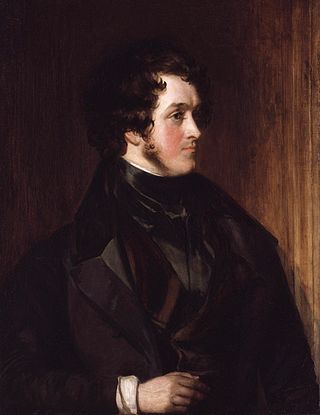
William Harrison Ainsworth was an English historical novelist born at King Street in Manchester. He trained as a lawyer, but the legal profession held no attraction for him. While completing his legal studies in London he met the publisher John Ebers, at that time manager of the King's Theatre, Haymarket. Ebers introduced Ainsworth to literary and dramatic circles, and to his daughter, who became Ainsworth's wife.
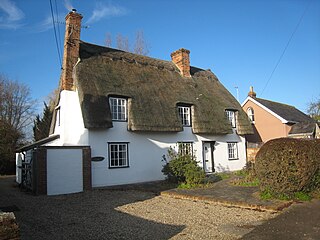
Little Dunmow is a village situated in the Uttlesford district, in rural Essex, England, in the vale of the River Chelmer about 3 miles (4.8 km) east-southeast of the town of Great Dunmow. It can be reached from the Dunmow South exit of the A120 by following the road towards Braintree (B1256) for 3.2 km before turning right for the village. The centre of the old village, which has just 99 dwellings, is a further 0.6 km along the road. The Flitch Way, a linear country park along the route of the old Braintree to Bishop's Stortford railway, links Little Dunmow and the new settlement of Flitch Green. The new village, built on the site of a former sugar beet factory, is a self-contained community of 850 dwellings and is another kilometre along the road towards Felsted.

This is a list of works by the English historical novelist William Harrison Ainsworth (1805–1882).
Artist and the Author is a pamphlet written by George Cruikshank in 1872. During the late 1860s, Cruikshank claimed to be the author of works attributed to other writers, including Charles Dickens and William Harrison Ainsworth. After John Forster contradicted Cruikshank's claims to having "originated" Oliver Twist, Cruikshank began a dispute in The Times as being the creator of novels attributed to Ainsworth. After the newspaper stopped carrying the dispute, Cruikshank produced all of his claims in Artist and the Author, where he disputed his relationship to 8 of Ainsworth's novels.

Windsor Castle is a novel by William Harrison Ainsworth serially published in 1842. It is a historical romance with gothic elements that depicts Henry VIII's pursuit of Anne Boleyn. Intertwined with the story are the actions of Herne the Hunter, a legendary ghost that haunts Windsor woods.
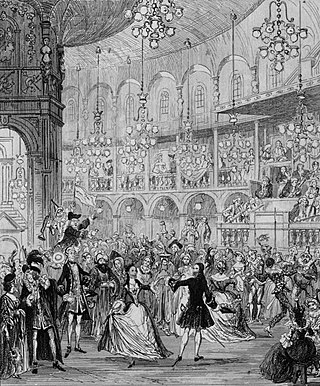
The Miser's Daughter is a novel by William Harrison Ainsworth serially published in 1842. It is a historical romance that describes a young man pursuing the daughter of a miserly rich man during the 18th century.

Jack Sheppard is a novel by William Harrison Ainsworth serially published in Bentley's Miscellany from 1839 to 1840, with illustrations by George Cruikshank. It is a historical romance and a Newgate novel based on the real life of the 18th-century criminal Jack Sheppard.
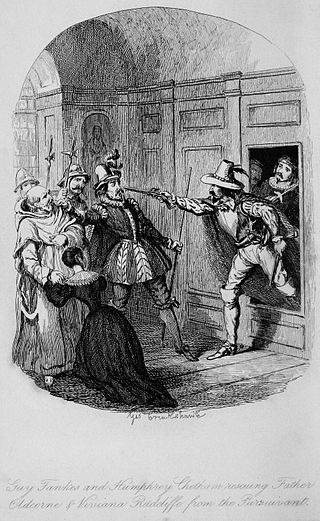
The novel Guy Fawkes first appeared as a serial in Bentley's Miscellany, between January and November 1840. It was subsequently published as a three-volume set in July 1841, with illustrations by George Cruikshank. The first of William Harrison Ainsworth's seven "Lancashire novels", the story is based on the Gunpowder Plot of 1605, an unsuccessful attempt to blow up the Houses of Parliament. Ainsworth relied heavily on historical documents describing the trial and execution of the conspirators, of whom Fawkes was one, but he also embellished the known facts. He invented the character of Viviana Radcliffe, daughter of the prominent Radcliffe family of Ordsall Hall – who becomes Fawkes's wife – and introduced gothic and supernatural elements into the story, such as the ability of the alchemist, John Dee, to raise the spirits of the dead.
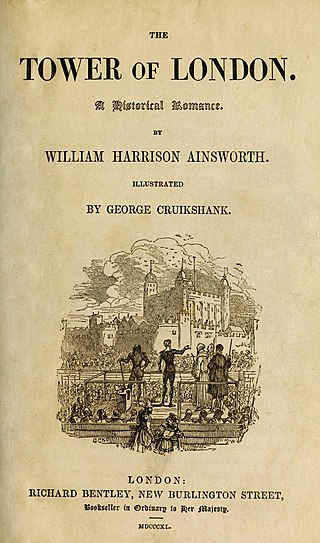
The Tower of London is a novel by William Harrison Ainsworth serially published in 1840. It is a historical romance that describes the history of Lady Jane Grey from her short-lived time as Queen of England to her execution.
St. James's is a novel by William Harrison Ainsworth serially published in 1844. It describes the events surrounding the end of Queen Anne's reign and the dispute between the Duke and Duchess of Marlborough with two Tories for influence over the queen.

Old St. Paul's, also titled Old Saint Paul's: A Tale of the Plague and the Fire, is a novel by William Harrison Ainsworth serially published in 1841. It is a historical romance that describes the events of the Great Plague of London and the Great Fire of London. It was the basis for the 1914 silent film Old St. Paul's.

Rookwood is a novel by William Harrison Ainsworth published in 1834. It is a historical and gothic romance that describes a dispute over the legitimate claim for the inheritance of Rookwood Place and the Rookwood family name.
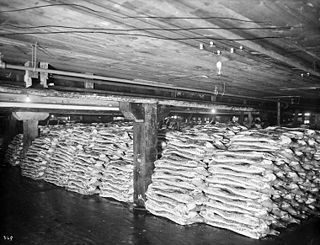
The awarding of a flitch of bacon to married couples who can swear to not having regretted their marriage for a year and a day is an old tradition, the remnants of which still survive in some pockets in England. The tradition was maintained at Wychnor Hall in Staffordshire until at least the eighteenth century, but now the flitch required to be held remains only as a carving over the fireplace. At Little Dunmow in Essex a similar ceremony also survived into the eighteenth century. The tradition can be traced back to at least the fourteenth century at both sites and the Dunmow flitch is referred to in Chaucer. The awarding of a flitch at both sites seems to have been an exceedingly rare event.

Arundel Terrace is a road in Kemp Town, Brighton, containing 1–13 Arundel Terrace, a row of Grade I listed buildings; numbers 12–13 are known as Arundel House. The buildings were built between 1824 and 1828 by Amon Wilds and Charles Busby.
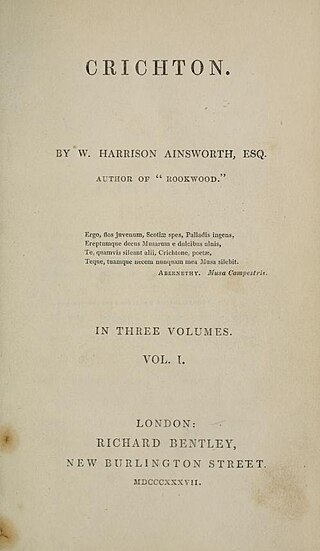
Crichton is an 1837 historical novel by the British writer William Harrison Ainsworth. It was published in three volumes by Richard Bentley. It is inspired by the life of the sixteenth century Scottish polymath James Crichton, known as the "Admiral Chrichton". It was Ainsworth's follow-up to the 1834 bestselling novel Rookwood.

The Flitch of Bacon is a 1778 comic opera composed by William Shield with a libretto by Henry Bate Dudley. It is inspired by the Flitch of Bacon tradition and takes place at Little Dunmow Priory in Essex. It premiered at the Theatre Royal, Haymarket in London on 17 August 1778. The original cast included William Parsons as Major Benbow, Charles Bannister as Captain Wilson, John Edwin as Tipple and Elizabeth Harpur as Eliza. The Irish premiere took place at the Crow Street Theatre in Dublin on 2 December 1779. The tradition later inspired the 1854 novel The Flitch of Bacon by William Harrison Ainsworth.
The Flitch of Bacon may refer to:

The Constable of the Tower is an 1861 historical novel by the British writher William Harrison Ainsworth. Originally serialised in Bentley's Miscellany it was then published in three volumes. It is set in Tudor England following the death of Henry VIII and focuses in particular in the rule of the Lord Protector Duke of Somerset and his subsequent downfall, imprisonment in the Tower of London and execution in 1552.. The illustrations were provided by John Gilbert. The sales of the novel were considered disappointing by his publishers Chapman and Hall.

John Law: The Projector is an 1864 historical novel by the British writer William Harrison Ainsworth. It was released in three volumes by the London publishing house Chapman and Hall. It focuses on the early eighteenth century Scottish financier John Law and his efforts to establish the Mississippi Company in Paris which ultimately went bankrupt after a speculative bubble.

Myddleton Pomfret is an 1868 novel by the British writer William Harrison Ainsworth, published in three volumes by Chapman and Hall. It was originally serialised in Bentley's Miscellany between July 1867 and March 1868. This was the last of his novels to feature in the magazine which ceased publication in 1868.
















